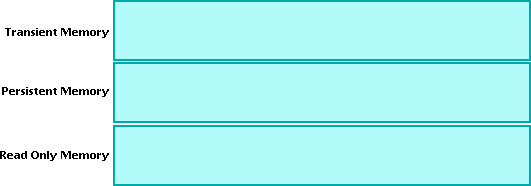
The contents of this article have been distilled from a recent presentation. The aim of both the presentation and this article is to dispell some common misconceptions about the Magic Cap memory model, and to describe efficient use of memory in a well behaved Magic Cap package. This article assumes that the reader is already familiar with developing for Magic Cap.
A metacluster represents a physical storage device, such as persistent RAM, transient RAM, ROM, and storage cards. There will always be metaclusters for persistent RAM, transient RAM and ROM. A metacluster will be created for a storage card when one is inserted.

A cluster holds a group of related objects. Clusters live inside of metaclusters. Examples of clusters are the system transient cluster, the package uncommitted changes cluster, the package committed changes cluster and the package source cluster.
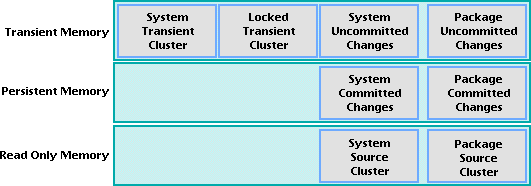
Most objects are located inside of clusters. A cluster maintains a directory of the objects it contains. This directory is known as the master block. Each object in a cluster has an entry in the cluster's master block, which contains an offset to the location of the object within the cluster. Objects are relocatable blocks of memory; Magic Cap can move objects around inside of clusters to make room for new objects. When the object moves, its master block entry is updated to reflect the new offset to the object. Because objects can move, you almost never use pointers to refer to an object. Instead, you use an ObjectID, which describes the cluster an object is in, and the master block entry containing the offset to that object.
A context tracks all clusters related to a particular package, or to the system. The system has a context object, called the system context, which groups together the clusters belonging to the system. Each package has a context object, called the package context, which groups together the clusters used by the package. Every package context also references the clusters belonging to the system. This means that system objects are always accessible from any package. Objects from one package are not immediately accessible from another package. Context objects live in the persistent RAM metacluster.
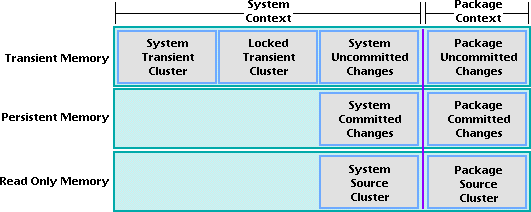
Context objects store the clusters and metaclusters associated with it in their extra data. Each cluster slot in a context object's extra data contains two entries. The first entry is the ObjectID of a cluster. The second entry is a pointer to the beginning of the cluster object.
| cluster number | cluster slot contents | cluster slot contents | cluster number |
|---|---|---|---|
| cluster 8 | A0000004 00BB5118 | A0000001 00B5A190 | cluster 88 |
| cluster 9 | 00000000 00000000 | 00000000 00000000 | cluster 98 |
| cluster A | 40B5A134 00B5A140 | 40AED03C 00AED048 | cluster A8 |
| cluster B | A800000B 00B252DC | 00000000 00000000 | cluster B8 |
| cluster C | A800000C 00B25AE8 | 00000000 00000000 | cluster C8 |
| cluster D | A8000002 00B34A2C | 00000000 00000000 | cluster D8 |
| cluster E | 00000000 00000000 | A8000001 00AED098 | cluster E8 |
| cluster F | 00000000 00000000 | 00000000 00000000 | cluster F8 |
| cluster 10 | 40714B82 00714B8E | A0000003 00B8310C | cluster 11 |
| cluster 12 | 88000001 00B5A5F4 | A0000017 00B5C8F8 | cluster 13 |
The con command in the debugger will show you this information about the current context. To dump the clusters associated with another context, you need to first dump the context object, then dump the extra data of the context object:
dobj <context>
dm . + <Context_dataOffset> $a0
You can tell the cluster an object resides in by looking at the high nybble of the object's ObjectID. Clusters 10, 11, 12, and 13, which represent the source and uncommitted changes clusters for the system and the package, are considered non-addressible. That is to say, you cannot create an ObjectID that will directly reference an object in any of these clusters. How these objects are accessed is discussed in the next section.
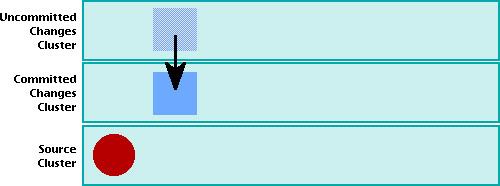
Even though uncommitted changes clusters are referred to as persistent clusters, they are actually located in transient memory. The system uncommitted changes cluster is known as cluster 8. The package uncommitted changes cluster is known as cluster B. When you specify a persistent object, Magic Cap first looks in the uncommitted changes cluster for the object. If the object doesn't exist in that cluster, Magic Cap looks in the committed changes cluster for the specified object. If the object doesn't exist there, either, Magic Cap looks in the source cluster. Thus, the high nybble of the ObjectID for a persistent object represents the first cluster of a cluster chain Magic Cap will search for that object.
There are no transient uncommitted clusters. This means that accessing transient objects is faster than accessing persistent objects, because Magic Cap does not have to search additional clusters to find the requested object.
The MemoryMonger package provides a working demonstration of how creating new objects affects the amount of memory available in transient and persistent clusters. Play with MemoryMonger and notice how persistent objects first take up space in the uncommitted changes cluster, and how the free space changes when those objects are moved into the committed changes cluster. Also watch how memory becomes available when you destroy objects.
When a package creates an instance of a class imported from another package, several objects are created in memory. The first object is created when the package calls Import() to import a class number from another package. The object returned from the Import() call is a Reference object located in the system context. When the foreign class is actually instantiated, two new objects are created in the package context. The first object is an instance of the ClassImport class. This is a special type of class that refers back to the actual class in the other package. This ClassImport object is added to the importing package's class list and given a unique class number. The second object is the instance itself, but its class number is the class number that was newly assigned to the ClassImport object, not the class number imported from the other package.
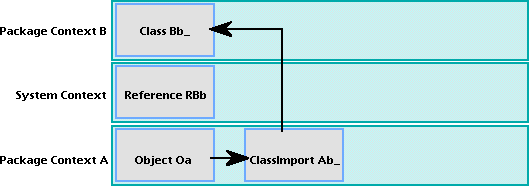
The calls BeginModifyFieldsOf() and BeginModifyExtra() will create shadow objects and return pointers to the newly created uncommitted shadows. This is because Magic Cap tries to protect the data in committed changes clusters, so you will not get writeable pointers to objects in these clusters.
Because transient clusters are not shadowed, changing transient objects is more efficient than changing perstent objects.
Most objects maintain strong relationships with other objects. This means that if one object refers to a second object, when the first object is destroyed or copied, the second object will be destroyed or copied with it. You can define a weak relationship between objects by specifying the noCopy keyword on field declarations in class definitions. (Newer versions of the class compiler allows the use of weak as a synonym for noCopy.) When an object weakly refers to a second object, the second object is not destroyed or copied with the first object.
Classes can specify that their instances are shared. Shared objects are not destroyed when objects that refer to them are destroyed. However, calling Destroy() directly on a shared object will destroy the object. Indexicals behave similarly to shared objects during object destruction. If the field of an object being destroyed contains an indexical reference, the object referred to by the indexical will not be destroyed. However, calling Destroy() directly on an indexical value will destroy the object the indexical refers to.

In the request phase, Magic Cap simply looks at each free block in a cluster to see if there is one free block that is large enough to create the new object from. If such a free block is found, the new object is chopped off the block, and a master block entry is allocated for the new object.
If there is no single free block in the cluster large enough to create the new object from, Magic Cap relocates objects to move free blocks next to each other so that they can be merged. This is the throw up phase. Magic Cap can't move blocks around locked blocks. This is why we always tell you not to change objects or allocate memory while an object is accessed. An object allocation request that encounters a locked object in the cluster will fail more often than not. Objects that will be permanently locked should be created in one of the locked clusters. These clusters are located at the bottom of their respective metaclusters so that they don't get in the way of object allocation/relocation inside the metacluster.
After all free blocks have been merged, and there is still not enough space in the cluster to allocate the new object, Magic Cap will start purging existing objects. An object passes through five purging levels before Magic Cap actually destroys it. This corresponds roughly to aging objects before they are destroyed, so older objects are purged before newer objects. After each object is purged, Magic Cap checks to see if enough memory is free to fulfill the allocation request. If there is, purging stops, and Magic Cap restarts the request phase to merge the new free blocks into the existing free block.
If, after all purgeable objects have been destroyed, there is still not enough memory to fulfill the allocation request, Magic Cap will try to compact objects. This is done by calling Compact() on objects, telling them to shrink themselves. Typically, the only objects that can shrink themselves in Magic Cap are list objects. If you create a class that can shrink its instances, you should override Compact().
In the last phase, Magic Cap will try to grow the cluster to make more free space. This is done at the expense of compacting other clusters in the same metacluster. If this phase fails to create enough free space to fulfill the allocation request, Magic Cap throws a cannotAllocateMemory exception. If this exception is uncaught, Magic Cap will reset if transient memory was full. If persistent memory was full and the exception is uncaught, Magic Cap will bring up the out of memory window.

Magic Cap performs garbage collection to reclaim persistent memory used by objects that are not referenced from other objects. This garbage collection is performed when Magic Cap communicators are powered off, and before the out of memory window is shown. Garbage collection is not performed on transient objects. Furthermore, transient objects are not scanned to see if they refer to persistent objects. This means that a persistent object that is only referenced from a transient object will be garbage collected anyway. Don't keep references to persistent objects in transient objects.
A lightweight form of garbage collection is performed every few minutes. During this time, string dictionaries which contain names of objects are stabilized, and entries for deleted objects are removed.
Reference objects are created whenever a package object is referenced from outside of that package's context. This happens when another package calls Import() to import an object or class number from the package, or when the package calls an operation defined by another package and passes package objects as parameters.
Reference objects are destroyed when the package object it references is destroyed. Reference objects are also destroyed when the package that owns the object being referenced is packed up. Persistent Reference objects that are not referenced by other objects can be garbage collected. Transient Reference objects are also destroyed when Magic Cap resets.
The important thing to realize is that fields that have been cleaned are not filled in with the values they used to contain when the package context that went away comes back. The only way that Magic Cap has of hooking objects together is with the install/receiver mechanism. Objects that are not in these lists cannot be hooked back together. Because most cross-context references do not appear in these lists, Magic Cap cannot piece them back together. This is also why it's important to keep subviews of a fileable viewable in the same cluster as the viewable. Consider the case where a card is created using a Preferred memory call; it might wind up in the new items package, which is a different package context. If the subviews of this card are not created in the same cluster as the card, you might wind up with a cross-context view chain. If the software package and the new items package are ever separated (one is packed up, or the two live on different physical storage devices and one is removed), the view chain will be broken and will not be pieced together.
You should almost always create objects using the Near memory calls. You would only use the Preferred memory calls to create viewable objects that can be filed, like cards and tasks. To create a view chain in the preferred container, use a Preferred memory call to create the root object, then use Near memory calls to create subview objects in the same cluster as the root viewable. Using the Near memory calls is always preferred!
Objects can be created in different clusters depending on whether the object is an instance of a system class or package class, and depending on the location of the package creating the object. The following table shows which cluster an object will be created in depending on the type of memory call used and where the calling package is located.
| Type of call used | Package in ROM | Package in main memory | Package on RAM card |
|---|---|---|---|
| NewNear(), system class, near package |
cluster b, main memory |
cluster b, main memory |
cluster b, card memory |
| NewNear(), package class, near package |
cluster b, main memory |
cluster b, main memory |
cluster b, card memory |
| NewPreferred(), system class, main memory |
cluster 8, main memory |
cluster b, main memory |
cluster 8, main memory |
| NewPreferred(), package class, main memory |
cluster b, main memory |
cluster b, main memory |
cluster b, card memory |
| NewPreferred(), system class, card memory |
new items, card memory, reference in cluster 8 |
new items, card memory, reference in cluster 8 |
new items, card memory, reference in cluster 8 |
| NewPreferred(), package class, card memory |
new items, card memory, reference in cluster 8 |
new items, card memory, reference in cluster 8 |
new items, card memory, reference in cluster 8 |
Even though the table uses cluster 8 and cluster b to describe the locations of persistent objects, keep in mind that the uncommitted changes clusters live in transient memory, which comes from built-in memory. The committed changes cluster will be located on the physical storage device described in each table entry.
Transient memory should be used to hold temporary objects, or for objects that can be rebuilt from other data. The most common cause of resetting communicators is when there is no more transient memory available for use. While there is only a limited amount of transient memory available, this does not mean you should avoid using transient memory completely. Transient memory is more efficient than persistent memory because it is not shadowed. By following some basic rules about how transient memory should be used, more transient memory would be available for everyone to use.
This doesn't mean that you need to set up an exception handler every single time. To be honest, if you can't allocate a 32-byte transient object for the duration of one routine, things are in pretty bad shape. But if you're going to be storing references to a transient object in some other object, or the transient object is relatively large (more than a few hundred bytes), you should be prepared to catch cannotAllocateMemory exceptions. Every out of memory exception that is caught makes the Magic Cap experience that much better.
Transient clusters are not destroyed in Magic Cap 1.5 when power is restored to the communicator. This means that Load() and Install() are not necessarily called in these cases any more. However, Reset() is still called on every power on to notify classes of the event. This means that Reset() methods that blindly allocate transient memory because they assume that transient clusters have been recreated are actually leaking transient memory. These methods should be re-written to either check to see if the transient object needs to be created, or move the allocation be performed into the Install() method.
The right way to use BeginModify()
This is the correct way to use a call that locks an object. The object is kept locked for a short duration, and no Magic Cap operations are called while the object is locked.
newCard = CreateNewCardNear(stationery, stack); objectPtr = BeginModify(object); objectPtr->card = newCard; EndModify(object);
The wrong way to use BeginModify()
This is an incorrect use of a call that locks an object. While the object is kept locked for a short duration, a Magic Cap operation that allocates memory is called while the object is locked. This will fail more often than not.
objectPtr = BeginModify(); objectPtr->card = CreateNewCardNear(stationery, stack); EndModify(object);
Calls that return pointers to objects will cause those objects to be locked. These calls are BeginReadFieldsOf(), BeginModifyFieldsOf(), BeginReadExtra() and BeginModifyExtra(). The corresponding End call will normally unlock the object. Magic Cap tracks accesses to locked objects, so that a call to EndRead() will not unlock an object if BeginReadFieldsOf() has been called on the object twice. Because BeginModifyFieldsOf() and BeginModifyExtra() will cause a shadow object to be created in the uncommitted changes cluster, you should never nest Modify calls.
Two final calls, NewLockedBuffer() and NewTransientBuffer(), will create locked objects in the locked transient cluster.
Purgeable objects are destroyed automatically if Magic Cap needs to reclaim the memory. You can override Purge() to be notified when an object is about to be purged.
In the optimal situation, there should be one unique instance of a shared object in any given cluster. If two stamps look the same, there should only be one Image object which is referenced by both Stamp objects. To ensure this optimal case, you should call DeleteDuplicate() every time you change or create a shared object. DeleteDuplicate() searches for objects that have the same checksum as your object in the cluster. If one is found, your instance is destroyed, and the ObjectID of the existing object is returned to the caller of DeleteDuplicate(). Any code that modifies a shared object but fails to call DeleteDuplicate() is potentially creating an extra copy of a shared object.
Using DeleteDuplicate()
This code snippet will cause a new LineStyle object to be created in the same cluster as the object referred to by self. Because line styles are shared objects, DeleteDuplicate() is called in case the new object matches an existing line style object in this cluster.
if (HasObject(lineStyle)) lineStyle = CopyNear(lineStyle, self); else lineStyle = NewNear(LineStyle_, self, nil); SetLineStyle(self, DeleteDuplicate(lineStyle));
Because a shared object can be referenced by more than one other object, you should not modify a shared object directly. Instead, make a copy with CopyNear(), make your changes, then call DeleteDuplicate() on your modified copy.
The key to these conventions is the encapsulation of data in an object. You should consider the data fields in objects to be private to that object; use the public attributes to access data from an object. In your own classes, you should define your getter attributes to return transient copies of the requested data; never return an object stored in a field. It is the responsibility of the caller of your getter to move the copy to where it wants it, and to destroy the copy when the caller is done with the data. Similarly, your setter attributes should never store the parameter that is passed in. Instead, it should call CopyNear() to move the parameter object into the same cluster as the object that will refer to it. This way, your setter does not make assumptions about what cluster the parameter object is located in.
This means that auto-getters and auto-setters will be less useful, since these do not do the appropriate copying. You can still use these for non-object field data, but you should write custom getters and setters for attributes that work with objects.
 Tech Docs
Tech Docs
 Magic Cap in Depth
Magic Cap in Depth